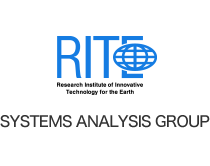Analysis Examples of Integrated Assessment Model DNE21
Model analyses in "CO2 Concentration Regulation Scenario - Stabilization of Atmospheric CO2 Concent
Technological scenario of CO2 emission reduction
"New Earth 21" Program
Technological scenario of CO2 emission reduction
This figure shows the cost-effective technological scenario of the world total CO2 emission reduction for the 550 ppmv atabilization. The figure provides a quantitative strategy of the "New Earth 21" program which was conceptually proposed by the Japanese government, using Integrated Assessment Model DNE21. The figure is generated using the difference in primary energy production, CO2 sequestration and emissions between the Reference Case and the 550 ppmv Stabilization Case.
The best mixture of technological options would minimize the system costs for the atmospheric CO2 concentration stabilization. Energy savings and conversions among fossil fuels play important roles before the middle of the 21st century, and CO2 sequestration technologies play important roles after the middle of the 21st century.

The short explanations can be seen by a click to a part of the figure.
CO2 Reduction by Energy Conservation
The CO2 emission reduction is achieved partly by the redcution in primary energy consumption relative to in the Reference Case.

CO2 Reduction by Energy Conversion among Fossil Fuels
The CO2 emission reduction is partly achieved by the conversion of fossil fuels use from carbon intensive energies, such as coal, to the less intensive energies, such as oil, natural gas, relative to in the Reference Case.

CO2 Reduction by Use of Non-fossil Fuels
The CO2 emission reduction is achieved partly by the increase in non-fossil fuel use relative to in the Reference Case.

Image of Underground Sequestration of CO2
This CO2 emission reduction option is a technology to capture CO2 from large-scale CO2 emission sources, e.g., fossil fuel power plants, and then to inject the recovered CO2 into aquifers, depleted gas wells or oil wells for the enhanced recovery.

→ To the CO2 Storage Research Group of RITE
Image of CO2 Ocean Sequestration
This CO2 emission reduction option is a technology to capture CO2 from large-scale CO2 emission sources, e.g., fossil fuel power plants, and then to inject the recovered CO2 into ocean.

→ To the page of the CO2 Ocean Sequestration Project of RITE
CO2 Reduction Effect by Reforestation
Reforestation is one of the options to reduce atmospheric CO2 concentration. However, net CO2 fixation occurs only when the forest is growing, and no net fixation for matured forests, and is not able to be fixed by matured forests. We also should pay attention to that the felling of the reforested forests cause CO2 release and that the CO2 fixation effect is canceled. In the figure of CO2 emission reduction scenaio, the forests or energy crops for energy use is counted as "Biomass energy" which is one of the renewable energies, and the CO2 reduction effect by reforestation excludes biomass as for energy use. Room for the reduction effect by reforestation reduces as time goes on, because land for the new reforestation is reduced.

